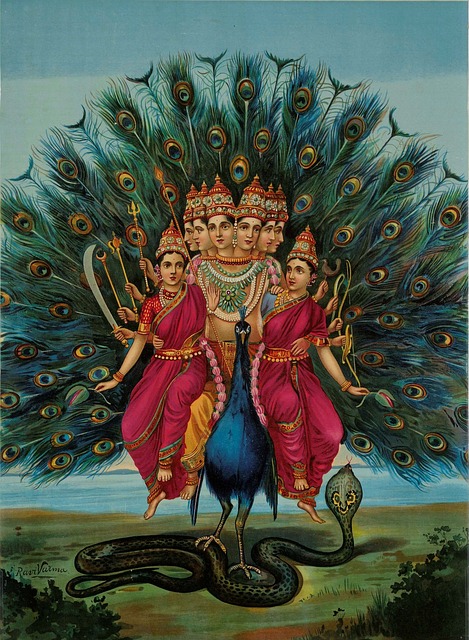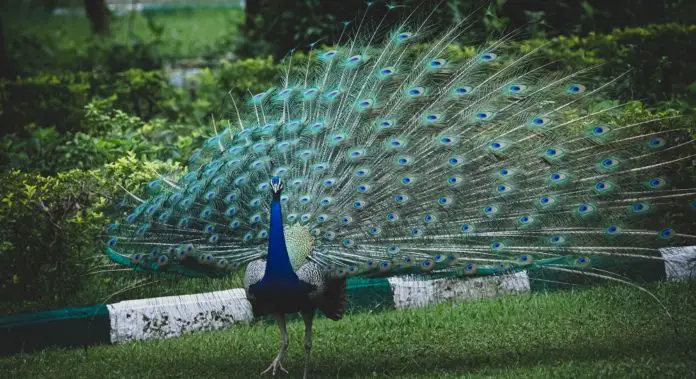An Introduction to Peacock Symbolism – If you’ve never seen a peacock, you will definitely be blown away by it! The male peacock can be easily distinguished from the female by its bright coloring and tail feathers with stunning eye-motifs. The females, surprisingly, are smaller and sport dull plumage.
So why are we doing a study of symbolism that has evolved around a brightly colored bird with a lot of feathers? For starters, the peacock has influenced world culture to the extent that a color has been named after it – peacock blue, and sometimes peacock green. The rich color and stunning plumage of the peacock has inspired a lot of creativity over centuries, producing art, literature, dance, and religion.
Studying peacock symbolism opens us to this world of religions, cultures, and ways of living that will take us through many countries across the world. Our study took some very surprising turns as we uncovered fascinating ways in which the peacock served as a symbol to so many different characteristics. Here’s a look at what we uncovered.
For over four thousand years the peacock has graced every imaginable place from lush jungles to extravagant palaces, cages on ships to portraits and legends of gods, and everything in between. The proud and beautiful creature has been the muse for art and literature for centuries. Studying the role, the peacock has played as a symbol in various cultures and religions across the world will give us a fascinating depiction of the variety and profundity of philosophy about beauty, morality, and religion.
Our journey begins in the home-country of the peacock and traces its travel through Asia and on towards the West. The sheer volume of information demands that the study be divided into three categories: Cultural symbols, Symbolism through History, and Religious symbols.
Peacock Symbolism – Cultural
The peacock feather is an integral part of Indian and South-east Asian culture and has been for centuries. You will find peacock feathers adorning everything from clothing and jewelry to houses and shrines. Peacock feathers, their eyes and their grace are symbols of beauty in these cultures. These have been imitated in various art forms including dramatic folk dances, local artistry, and literature.
It is an auspicious symbol to have peacock feathers decorating the threshold of houses in India as a power that wards off the evil eye. It is also used in the Indian religio-scientific practice called Vastu Shastra. Placed in the right location, the peacock feather is said to attract wealth in leaps and bounds.
Indians and people in other Hindu cultures also believe that when a peacock is seen dancing in all its plumed glory, heavy rains are on the way. Another belief is that when a peacock squawks loudly and continuously, a death is being heralded.
India is a prime example of how the peacock is more than just a religious symbol. The country has adopted the bird as their national symbol, invoking its features of grace, pride, and beauty for its people. It is a protected species under the Indian Wildlife Protection Act, 1972.
If you were to visit Sri Lanka, you would be fascinated by the magnificent display of culture there, and you are sure to be treated to the lovely peacock dance. Thailand is another place where you will find a local rendition of this dance. Each of these places style their costumes, make up and dance moves to imitate the peacock and capture its beauty and grace.
Looking just a little further on, the Chinese consider the peacock as another manifestation of the Phoenix. It has been labelled one of the ‘Twelve Signs of Sovereignty’ and can be seen in royal attire and accessories. The peacock symbolizes fame and positive vibes from the outside world. It is credited with being able to revive dying relationships, with its innate vitality. In the ancient art of Feng Shui, the peacock symbol acts as a good-luck charm for those who are looking for love.
In the year 2013, the Smithsonian Institute’s Folklife Festival Program featured Hungary’s folk heritage and history, celebrating native cultural practices, art, folk music and dance, and other elements that were intrinsic to Hungarian heritage. The all-encompassing motif that year was the peacock bird with its outstretched tail, most probably symbolizing the blazing sun. This motif was carefully chosen for this festival to depict how important the symbol of the peacock is to Hungarian culture.
The peacock bird serves as an important symbol of love and freedom, as well as purity and light in Hungarian culture. It is a recurring theme, symbolizing love, sewn into the wedding trousseau of the Hungarian bride. It is also widely seen in architecture and interior design. But the true importance of the bird is seen in Hungarian folk music. Peacocks were seen in songs and poems from daily life, as well as in war literature. It served as a symbol of salvation and freedom in revolutionary literature. Isn’t it amazing how this beautiful bird has caught the hearts and minds of an entire nation?
Peacock Symbolism Through History
In many cultures around the world, including its birthplace India, the peacock was revered as a symbol of power. Kings and other members of royalty wove peacocks into their fabrics, inlaid them in jewelry, and had them adorn their thrones and sceptre as symbols of power and strength.
The most famous of such artifacts was the Peacock Throne, built in the early 1700s for the Mughal Emperor Shah Jahan, whose dynasty was known for splendid architecture. Unfortunately, the magnificent throne was lost to history when Persian ruler Nadir Shah captured the Kingdom and took the throne back to his own country. It was never heard of again, though a number of thrones have borne the name of the Peacock Throne. It has never been matched in splendor and richness in any of its successors.
China’s powerful Ming Dynasty was known to embrace the peacock as its imperial symbol, representing rank, divinity, power, and beauty. Doesn’t that take you right back to Kung Fu Panda 2 – the one in which Po finds his real family? The depiction of the peacock as a master of Kung Fu, and as a monarch is stunning!
When trade began and exchange of ideas and cultures started taking place, the peacock had also begun to travel. It had now become a part of the cache of luxury products that came from the ‘exotic’ world as it made its way to European countries.
The Peacock Room at the Freer Gallery of Art in Washington DC is a well-known tribute to the peacock in the European world. It is painted in brilliant blue-green hues and embellished with breath-taking gold work. Painted between 1866- 67, it is considered a prime example of Anglo-Japanese art, and one of the best surviving works of aesthetic interiors.
On your next trip to Italy, make sure to visit Leccio, a 45-minute drive from Florence. You will find another prime example of the exchange of cultures in the breath-taking Castello di Sammezzano. The foundations of the place date back to the era of the Roman Empire, and some of its most famous visitors may have been Charlemagne, and even the Medici family. It was originally a villa, and also served as a fortress, but in the 1800s the Marquis Ferdinando transformed it into one of the most opulent castellas to date. Get this: the castella boasts a whopping 365 rooms – one for each day of the year! Nestled among them all is the extravagant Peacock Room, boasting swirls of geometric patterns decorated as peacock feathers in brilliant hues. It’s a treat for any travel enthusiast, and also an important relic that depicts a mixture of styles borrowed from across cultures, and even across centuries of artistic expression.
But before all of these modern cultures, the Romans themselves had discovered that the peacock bird was a prized possession. They had the dual purpose of representing funerals and death on the one hand, and resurrection on the other. This was because the Romans discovered that their feathers never faded. This was seen as a sign of their immortality.
But the funky colors and the regal plumage serving as symbols was only part of the package. Peacock meat and tongue of peacock were delicacies in early Roman cuisine. Interestingly, the bird was carefully skinned with the feathers intact, cooked to perfection and then served within the skin and plumage. That would have definitely been a dish to gawk at!
Did you know that the Greeks believed that the peacock never decayed after its death? Pythagoras claimed that the soul of Homer found eternal home in a peacock after his death. He was right in a way – the ancient Greek poet is studied even today, isn’t he? The Greeks were quick to absorb the peacock into their folklore and assigned it the favored pet of Hera.
Peacocks As Religious Symbols
Almost every religion that has come in contact with the peacock has adopted it as a symbol. The birds are native to South-east Asia, particularly India, Bangladesh, and Pakistan. But with time and travel the magnificent creatures came to influence a wide range and number of cultures and religions throughout the world.
Let’s take a look at ways in which some of the major religions of the world have used the peacock as a symbol.
- Peacock symbolism in Hinduism:
The peacock has long been an integral part of Hinduism. With its mystic beauty and vibrant coloring, the bird has been associated with two important figures in the Hindu Pantheon – Goddess Saraswathi and the beloved Lord Krishna.
According to Hindu mythology, the peacock is said to have been created from the feathers of Garuda, the sacred animal vehicle of Lord Indra. Oftentimes you will find the peacock associated with Goddess Saraswathi as well. Here it is meant to symbolize wealth, prosperity, as well as virtue, patience, and kindness.
Lord Krishna was said to love the peacock so much that his head was always decorated with peacock feathers. This was also a favorite embellishment for his prized flute. It is said that the peacock kingdom was so enamored by Lord Krishna’s flute-playing that their king offered his tail feathers to him in humble tribute.
The peacock has its own identity as a divine vehicle. The Goddess Kaumari, another avatar of Shakti, rides the peacock.

The Hindu God of war, Murugan, or Kartikeya, also uses the peacock as a mount. Interestingly, some depictions of Murugan show him riding a life-sized peacock trampling a large snake – a clear depiction of his victory over evil.
There is a story in Hindu Mythology which explains how the peacock got its beautiful tail feathers. In a fierce battle between the evil Ravana and Lord Indira, the peacock willingly used his tail to shield Indira from the onslaught of Ravana. As a reward, Indira glamorized the peacock’s tail into the beautiful bouquet we see today.
In another context, the peacock is a symbol of victory over evil. Quite surprisingly, this exotic bird feeds on poisonous snakes and remains unaffected by their venom. The Hindus believe that far from harming the bird, the poison lends greater luster to their tail feathers. This gives room for another parallelism: one is not to be overcome by evil, but to overcome it, and become strengthened by it. In many Hindu sculptures, the peacock depicts the cyclical nature of time.
- Peacock symbolism in Christianity
Peacock symbolism is also seen in Christianity, especially early in the Byzantine era. Did you know that the peacock sheds its tail feathers and regrows them seasonally? This trait of the peacock is used to symbolize death and resurrection in the Christian religion. It is a clear off-shoot from the ancient Roman belief. This is clearly seen in ancient tombs and paintings on graves. In some Christian cultures, the dead are buried with peacock feathers to symbolize the purity of the soul that can no longer be maligned.
- Peacock symbolism in Islam
There are many conflicting stories about peacocks in Islamic folklore. Some of these glorify the bird as the one who started the Islamic tradition of prayer. Other stories cast the peacock in a negative light. They claim that the peacock was once the Phoenix and had a beautiful singing voice. When the serpent persuades the peacock to let him enter heaven, he is cast out, along with the serpent and is reduced to his current form and voice.
- Peacock symbolism in Buddhism
The Buddhists have their own share of symbolic meanings to assign to the peacock. These include long-life and even immortality. Just like Indians, they also noticed that the peacock could consume poisonous plants and not be affected by them. Buddhists teach that in this way the peacock teaches one to live strong through suffering. Peacock feathers are also used in cleansing rituals since this bird also symbolizes purity.
Furthermore, the peacock’s open tail represents the open Chinese fan – a symbol of welcome and openness. If you think about it, the Chinese fan can be seen as inspired by the peacock’s tail!
Peacock Symbolism Today
There are many other cultures and religions in which peacock symbolism has an important role to play. The air of mystery and grace that surrounds it continues to fascinate people around the world, even today. You can find them in art of various kinds, including interior decor, sculpture, fabric art, tattoos, digital art and even cartooning.
You’d actually be surprised at where you find the beautiful bird these days. It still remains a sign of beauty, power, and rebirth. Think back to where you might have seen the peacock recently. Ever noticed the famous logo of NBC, as well as the live streaming service called Peacock TV? After a series of changes, the company settled on a multi-color peacock symbol that rests above the company’s letters.




